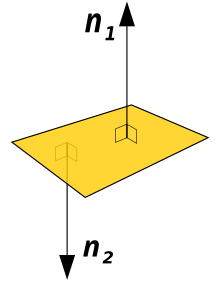

In geometry, a normal is an object (e.g. a line, ray, or vector) that is perpendicular to a given object. For example, the normal line to a plane curve at a given point is the line perpendicular to the tangent line to the curve at the point.
A normal vector of length one is called a unit normal vector. A curvature vector is a normal vector whose length is the curvature of the object. Multiplying a normal vector by −1 results in the opposite vector, which may be used for indicating sides (e.g., interior or exterior).
In three-dimensional space, a surface normal, or simply normal, to a surface at point P is a vector perpendicular to the tangent plane of the surface at P. The word normal is also used as an adjective: a line normal to a plane, the normal component of a force, the normal vector, etc. The concept of normality generalizes to orthogonality (right angles).
The concept has been generalized to differentiable manifolds of arbitrary dimension embedded in a Euclidean space. The normal vector space or normal space of a manifold at point is the set of vectors which are orthogonal to the tangent space at Normal vectors are of special interest in the case of smooth curves and smooth surfaces.
The normal is often used in 3D computer graphics (notice the singular, as only one normal will be defined) to determine a surface's orientation toward a light source for flat shading, or the orientation of each of the surface's corners (vertices) to mimic a curved surface with Phong shading.
The foot of a normal at a point of interest Q (analogous to the foot of a perpendicular) can be defined at the point P on the surface where the normal vector contains Q. The normal distance of a point Q to a curve or to a surface is the Euclidean distance between Q and its foot P.

